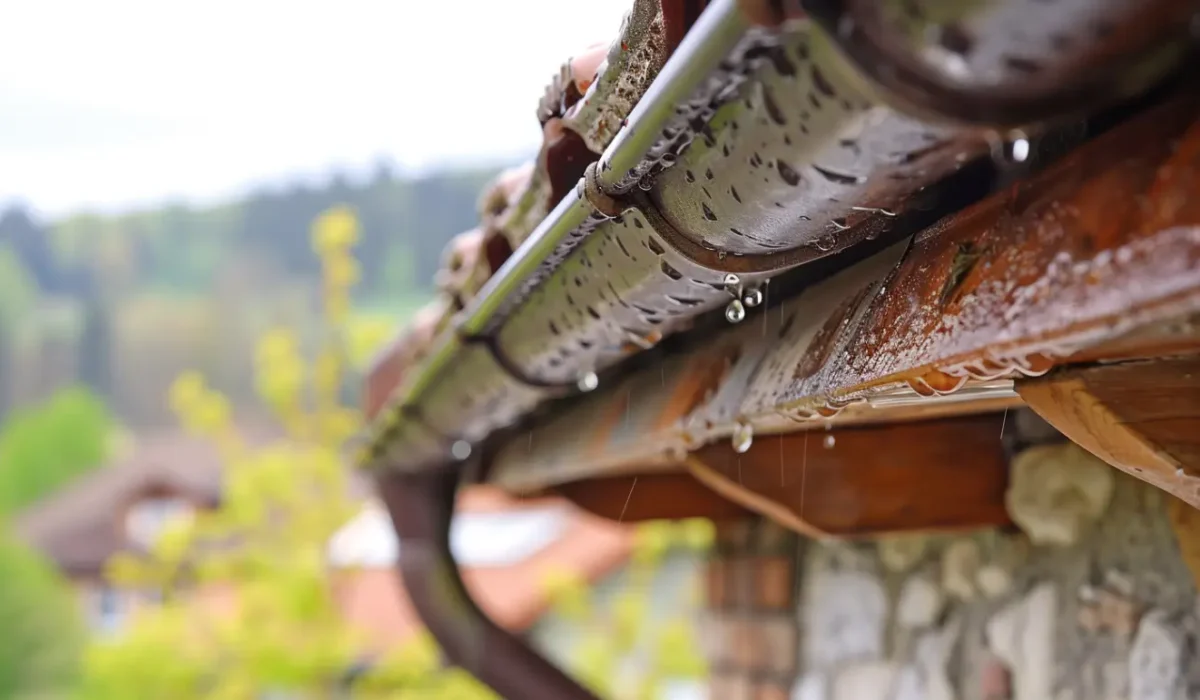Your roof is the first line of defense for your home against rain, wind, and snow. At KangaRoof in Coppell, TX, we understand the importance of caring for your roof to ensure it performs well. Over time, leaves, twigs, and other debris can build up on your roof. This is not just messy; it can lead to significant drainage problems. Our team at KangaRoof is equipped to address debris issues, preventing damage to your roofing materials. When debris is left unchecked, water may find its way into your home. Knowing how roof debris is linked to leaks is the first step in roof maintenance, and at KangaRoof, we help you protect your property and avoid costly repairs.
Understanding Roof Debris and Its Impact
Accumulation of various types of debris on roofs significantly impacts the effectiveness of roof drainage systems. Leaves, twigs, and asphalt shingles can block water flow, preventing proper drainage and leading to moisture buildup. This underlines the importance of routine inspections to identify vulnerable areas. Addressing roof debris not only enhances drainage efficiency but also protects the roof’s integrity against severe weather conditions. Neglecting this can result in costly repairs due to water intrusion and structural damage in the long run.
Contact Us

Types of Debris That Accumulate on Roofs
Leaves, twigs, and small branches frequently gather on roofs, particularly during fall or after storms. This organic matter can lead to moisture buildup and promote mold growth if not cleared. Additionally, roofing materials such as asphalt shingles may shed granules over time, contributing to debris accumulation. Other potential offenders include dirt, dust, and even animal nests, which can obstruct proper drainage. Regular inspections are essential to identify and address these vulnerabilities before they evolve into more serious drainage problems.
How Debris Builds Up Over Time
Over time, roofs become susceptible to debris accumulation due to various environmental factors. Leaves, twigs, and dirt can collect at the edges of the roof, especially in vulnerable areas where wind and heavy rain deposit materials. Neglecting routine inspections can result in moisture buildup, leading to significant drainage problems that compromise the roof’s integrity. Without proper maintenance, these accumulations may harden, trapping water and creating a breeding ground for mold growth, ultimately increasing the risk of costly repairs and extensive damage.

The Link Between Roof Debris and Drainage Problems
Blockages caused by accumulated roof debris create significant drainage problems. Leaves, branches, and dirt obstruct gutters and downspouts, leading to poor water flow and potential overflow. In flat roof systems, debris can exacerbate water pooling, while sloped roofs may experience direct water accumulation at vulnerable edges. This disruption of the roof drainage system not only increases the risk of water infiltration but also contributes to moisture buildup, ultimately undermining the roof’s integrity and exposing buildings to further damage.
How Debris Blocks Gutters and Downspouts
Accumulation of organic materials, such as leaves and twigs, along with man-made debris can obstruct gutters and downspouts, severely impeding effective roof drainage. When these channels are blocked, water pooling occurs, leading to moisture buildup that can infiltrate the roofing materials and building structure. Over time, this creates vulnerabilities within the system, resulting in costly repairs and potential structural damage. Regular inspections and proactive maintenance are essential for ensuring proper drainage, especially following heavy rains or severe weather conditions.
Effects on Flat Versus Sloped Roof Drainage Systems
Differences between flat and sloped roof drainage systems significantly influence how efficiently water flows off the roofing materials. Flat roofs are more susceptible to water accumulation due to limited gravity assistance, often resulting in standing water and moisture buildup, which can lead to roof leaks. In contrast, sloped roofs allow for effective water drainage, reducing the risk of debris blockage. However, both systems require regular inspections and maintenance to prevent drainage problems and ensure the overall integrity of the building structure.

Common Signs of Roof Drainage Issues Caused by Debris
Water pooling around the edges of the roof often indicates underlying drainage problems exacerbated by roof debris. Such accumulation can lead to visible water stains, which signal potential water intrusion into the building structure, calling for immediate attention. Stains on ceilings, walls, or even mold growth within the home are crucial signs of unchecked moisture buildup. Engaging a roofing professional for regular inspections can highlight these issues early, preventing significant damage and ensuring the roof’s integrity remains intact.
Visible Water Pooling and Overflow
Visible signs of water pooling on the roof can indicate significant drainage problems, particularly when debris obstructs proper water flow. This accumulation creates vulnerable areas where moisture buildup leads to internal drainage issues. As water overflows from the edges of the roof, it poses a risk of water intrusion and can damage roofing materials. Addressing these concerns promptly through routine inspections and maintenance is crucial to preserve the roof’s integrity and prevent extensive damage to the building structure.
Stains, Mold, and Mildew Inside the Home
Visible stains on ceilings and walls often signal underlying roof drainage issues. Water intrusion due to debris-clogged gutters can lead to moisture buildup, creating an ideal environment for mold and mildew. Over time, this not only compromises the aesthetic appeal of the property but also presents health risks for residents. Routine inspections by a roofing professional can identify vulnerable areas early, preventing extensive damage. Addressing these issues promptly is essential for maintaining the roof’s integrity and ensuring effective roof drainage.

How Clogged Roof Drains Lead to Interior Leaks
Clogged roof drains can create significant pathways for water infiltration into the building structure. When drains become blocked, water accumulation occurs, especially during heavy rain, leading to standing water pooling on the roof. Over time, this excess moisture can penetrate the roofing materials, compromising the roof’s integrity and resulting in leaks. Prolonged exposure to water can also cause structural damage, energy efficiency issues, and even mold growth, which poses various health risks for occupants. Regular inspections and maintenance can prevent these costly repairs.
Pathways Water Takes Into the Building
Moisture accumulation on roofs can create several pathways for water to infiltrate a building. Gutter blockages lead to water overflowing at the edges of the roof, allowing direct water access to vulnerable areas like walls and windows. Additionally, compromised roofing materials, such as missing shingles, can expose the roof deck and facilitate leaks. Flat roof drainage systems are particularly at risk, as water pooling can penetrate the roof membrane, resulting in costly repairs and significant damage to the building’s structure.
Structural Damage from Prolonged Moisture Exposure
Extended periods of moisture exposure can lead to significant structural damage, compromising a building’s integrity. Water intrusion through vulnerable areas, such as gaps in roofing materials or around fixtures, can weaken the roof deck and framing. This can result in costly repairs, including the need for extensive roof maintenance. Without proper drainage and regular inspections, water accumulation creates a habitat for mold growth, further risking the health of inhabitants and the strength of the foundation. Taking proactive steps to address drainage problems is crucial.
What’s Next
Recognizing the critical role of effective roof drainage not only safeguards your home’s integrity but also prevents costly repairs stemming from water damage. Our certificates, including OC Preferred, Emerald Premium Plus, and GAF Master Elite, ensure that you receive top-quality service and materials. Regular inspections and proactive maintenance serve as the first line of defense against debris accumulation that can lead to significant drainage issues. Addressing these concerns promptly minimizes risks of structural damage and health hazards like mold growth. By ensuring proper ventilation and drainage systems are in place, homeowners can protect their investments from severe weather impacts and local building codes.
Frequently Asked Questions
Can debris on roof cause leaks?
Yes, debris on the roof can cause leaks by obstructing drainage systems. When gutters and downspouts are blocked, water accumulates, leading to overflow and potential water entry points. Over time, this moisture exposure can result in significant structural damage and interior leaks.
How does debris affect the roof?
Debris accumulation on roofs can obstruct drainage systems, leading to water pooling and increased weight. This pressure may cause structural damage, promote mold growth, and ultimately lead to leaks inside the building. Regular maintenance is essential to prevent these adverse effects.
Read our blog: Best Roofing Options for Businesses in Keller, TX
